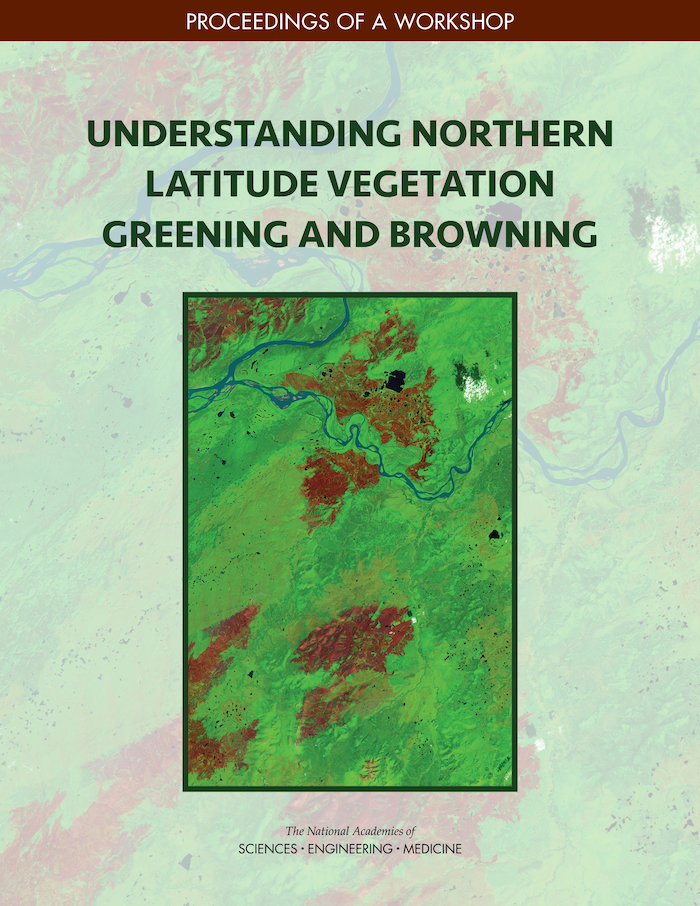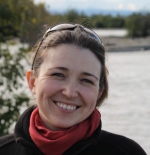By: April Melvin, Program Officer, Polar Research Board, National Academies of Sciences, Engineering, and Medicine
The Polar Research Board, in collaboration with the Board on Life Sciences of the National Academies of Sciences, Engineering, and Medicine, convened a workshop in December 2018 to discuss vegetation greening and browning in tundra and boreal ecosystems.

Vegetation change has been observed across Arctic and boreal regions
Studies have often documented large-scale greening trends (i.e. increased plant productivity and measured "greenness") but they have also identified areas of browning (decreased productivity) or shifts between greening and browning over varying spatial extents and time periods. At the same time, there are large portions of these ecosystems that have not exhibited measurable trends in greening or browning. These findings have fueled many questions about observed trends and identified drivers, implications of vegetation change, and methods and tools for evaluating changes and their uncertainties. These topical areas formed the primary themes of the workshop that were discussed by experts representing remote sensing and field-based research communities from U.S. and international institutions.
Drivers of greening and browning trends
Drivers discussed at the workshop included climate change and a variety of disturbance types, including many that are commonly linked to warming. Warming has been shown to contribute directly to greening trends in tundra by stimulating plant growth and shifting the landscape toward increased plant (including shrub) cover. Fire is a major disturbance in boreal forest that has increased in extent and severity with warming and has been linked to browning trends, and there is increasing concern that fires will also become more frequent in tundra. Insect infestations also cause browning as trees are either killed or defoliated. Harvest of high-productivity tree species, particularly in Canada, was also discussed as a common disturbance that decreases forest cover and can contribute to browning.
Implications
The potential implications of vegetation change and related greening and browning patterns extend from local to global scales. The Earth's surface energy balance is strongly affected by albedo (reflectance), which varies with the color of vegetation and the presence of snow on the vegetation surface. Shifts in plant species composition that often occur following a disturbance were also discussed. Areas often exhibit browning initially, followed by greening as the ecosystem recovers either to a state similar to pre-disturbance, or to a new state in which plant-soil-microbial feedbacks are altered, with implications for carbon and nutrient cycling and storage, permafrost thaw, and greenhouse gas release, among other processes.
Vegetation change can also affect wildlife and hunting and have other societal impacts. Researchers are currently investigating linkages between migratory caribou, preferred food sources, and trends in greening and browning. Vegetation change, particularly increasing shrub cover, was also discussed as a possible hindrance to hunters' ability to visually find animals and as a negative impact on travel to hunting areas. A benefit of increasing shrub abundance around villages at high latitudes may be the increased use of shrubs as a fuel source.
Methods to evaluate greening and browning
Commonly used methodologies include remote sensing platforms (satellites, airborne campaigns, drones, etc.) and field-based approaches that measure plant growth, percentage cover, leaf greenup and senescence, as well as eddy covariance (a micro-meteorological method used to directly observe the exchanges of gas, energy, and momentum between ecosystems and the atmosphere). Remote sensing is a useful tool because it can capture information across vast regions that are largely inaccessible over land. Many remote sensing platforms also provide relatively long records that can be analyzed to determine trends. A tradeoff, however, is that these datasets are often at coarse spatial and temporal resolution and therefore may be unable to detect smaller-scale changes that are observable when using field-based methods. Field measurements allow for fine-resolution evaluation of productivity drivers and may identify changes that are only discernible at a local scale. Field-collected data are also important for validating findings of remote sensing studies.
The importance of the scale at which data are collected was a recurrent theme throughout the workshop. Participants emphasized that moving toward increased collection of data at finer spatial and temporal scales, with improved bridging of information across scales, would help to address observable inconsistencies that currently exist when comparing greening and browning patterns and trends across datasets. Expanded efforts to integrate new technologies and tools that have become available could also advance understanding.
Further information is available in the Workshop Proceedings that summarize presentations and discussions at the workshop, released on 18 April 2019. Additionally, a public webinar was held on 14 May 2019.
 April Melvin is an environmental scientist and policy professional with experience studying the impacts of climate change and air pollution on society and the environment. She is currently a Program Officer at the National Academies of Sciences, Engineering, and Medicine where she coordinates the development of consensus reports and workshops for the Board on Atmospheric Sciences and Climate and the Polar Research Board.
April Melvin is an environmental scientist and policy professional with experience studying the impacts of climate change and air pollution on society and the environment. She is currently a Program Officer at the National Academies of Sciences, Engineering, and Medicine where she coordinates the development of consensus reports and workshops for the Board on Atmospheric Sciences and Climate and the Polar Research Board.
